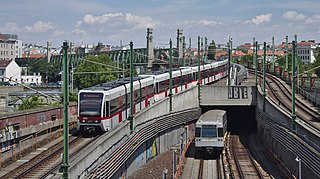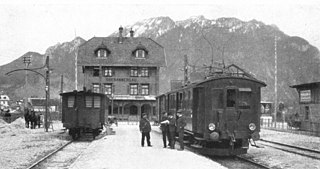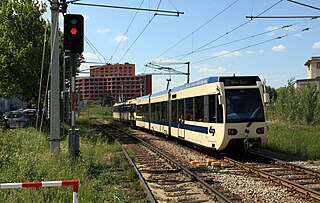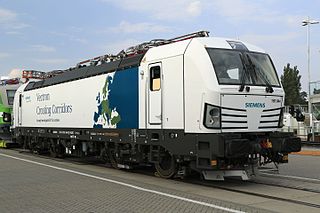
The Vienna U-Bahn, where U-Bahn is an abbreviation of the German word Untergrundbahn, is a rapid transit system serving Vienna, Austria. The five-line network consists of 83.1 kilometers (51.6 mi) of route, serving 109 stations. It is the backbone of what the International Association of Public Transport (UITP) deemed one of the best-performing public transport systems worldwide in 2009. 459.8 million passengers rode the U-Bahn in 2019. The network is undergoing expansion and rolling stock renewal. Since 1969, 200 million euros have been invested annually in the extension of the Vienna U-Bahn.

Wiener Linien is the company running most of the public transit network in the city of Vienna, Austria. It is part of the city corporation Wiener Stadtwerke.

Vienna has an extensive transport system that includes roads, railways, trams, metro, and buses.

DB Cargo Polska is a Polish company operating mainly in rail freight transportation. It is presently owned by the German state railway company Deutsche Bahn (DB).

The Vienna S-Bahn is a suburban commuter rail network in Vienna, Austria. As opposed to the city-run urban metro network, the Vienna U-Bahn, it extends beyond the borders of the city, is operated by the ÖBB, and consists of many branch lines. S-Bahn is short for Schnellbahn, which can be translated as "rapid railway".

Wien Südbahnhof was Vienna's largest railway terminus. It closed in December 2009 and was demolished in 2010 to be replaced with a new station, Wien Hauptbahnhof. It was located in Favoriten, in the south-east of the city. The East-bound rail services of Südbahnhof remained in operation until 2012 at a temporary train station "Südbahnhof (Ostbahn)".

The EuroSprinter family of electric locomotives is a modular concept of locomotives for the European market built by Siemens Mobility. The internal Siemens product name is ES 64, with ES for EuroSprinter and the number 64 indicating the 6,400 kW power at rail.

Railjet is a high-speed rail service in Europe operated by Austrian Federal Railways (ÖBB) and Czech Railways (ČD). Branded as Railjet Express (RJX) for the fastest services and as Railjet (RJ) for services with additional stops, it was introduced in 2008 and operates at speeds of up to 230 km/h (143 mph). Railjet is ÖBB's premier service and operates both domestically within Austria and on international services to adjacent major cities in the Czech Republic, Germany, Switzerland, Italy, Hungary and Slovakia.

A Lokalbahn or Localbahn is a secondary railway line worked by local trains serving rural areas, typically in Austria and the south German states of Bavaria and Baden-Württemberg. Lokalbahnen appeared at the end of the 19th century before the use of cars became widespread.

The Badner Bahn or Wiener Lokalbahn is a tram-train service in the metropolitan area of Vienna. It runs for 30.4 kilometres (18.9 mi) between Vienna and Baden, and is operated by the Wiener Lokalbahnen Aktiengesellschaft. The entire Badner Bahn is part of the Verkehrsverbund Ost-Region and is one of the most important passenger services owned by WLB. In 2013, 35,000 passengers per day used the service.

Linz Hauptbahnhof or Linz Central Station is a railway station in Linz, the third largest city in Austria, and capital city of the federal state of Upper Austria. Opened in 1858, the station is the centrepiece of the Linz transport hub. It forms part of the Western Railway, and is also a terminus of the Pyhrn Railway, the Summerauer Railway, and the Linzer Lokalbahn (LILO). The station is owned by the Austrian Federal Railways (ÖBB); train services are operated by the ÖBB and the LILO. With 40,800 passengers daily in 2018/2019, it is the busiest station in Austria outside of Vienna, and the 7th-busiest overall.

Wiener Neustadt Hauptbahnhof is a railway station in Wiener Neustadt, in the federal state of Lower Austria, south of Vienna. With over 700 trains and 25,000 passengers each day, the station is the busiest in Lower Austria.

The Southern Railway is a railway in Austria that runs from Vienna to Graz and the border with Slovenia at Spielfeld via Semmering and Bruck an der Mur. Along with the Spielfeld-Straß–Trieste railway, it forms part of the Austrian Southern Railway that connected Vienna with Trieste, the main seaport of the Austro-Hungarian Monarchy, via Ljubljana. A main obstacle in its construction was getting over the Semmering Pass over the Northern Limestone Alps. The twin-track, electrified section that runs through the current territory of Austria is owned and operated by Austrian Federal Railways (ÖBB) and is one of the major lines in the country.

The Vectron is a locomotive series made by Siemens Mobility, introduced at the 2010 InnoTrans trade fair in four prototype versions: diesel, multi-system, and both AC and DC electric power. The diesel version has been replaced in 2018 by a dual mode locomotive which is powered by electricity on electrified sections of the track and can be switched to diesel mode on non-electrified sections. The Vectron series is reconfigurable and modular, with a Bo'Bo' wheel arrangement, and is intended as the successor to the EuroSprinter family of locomotives. A more affordable, basic version called Smartron was introduced in 2018.

The Class 380 is a tri-voltage electric locomotive manufactured by Škoda for Czech railways České dráhy.

Trams in Vienna are a vital part of the public transport system in Vienna, capital city of Austria. In operation since 1865, with the completion of a 2 km (1.2 mi) route to industrial estates near Simmering, it reached its maximum extent of 292 km (181.4 mi) in 1942. In February 2015, it was the fifth largest tram network in the world, at about 176.9 kilometres (109.9 mi) in total length and 1,071 stations.

Line U2 is a line on the Vienna U-Bahn metro system. Opened in 1980, it currently has 20 stations and a total length of 16.7 km (10.4 mi), from Karlsplatz to Seestadt. It is connected to U1 at Karlsplatz and Praterstern, U3 at Volkstheater, U4 at Karlsplatz and Schottenring.

ČD Cargo, a.s. is a state-owned Czech railway operator focused on freight operations. It is a wholly-owned subsidiary of the passenger railway operator České dráhy.

Wien Hetzendorf is a Vienna S-Bahn station, served by S1 and S2. The station is 1.63 km (1.01 mi) west of Wien Meidling. The station is situated between Altmannsdorfer Straße and Hetzendorfer Straße. Connections are available to Lines 16A, 62A, 64A of Wiener Linien Bus service and Line 62 of Wiener Linien Tram service.
The Vienna semi-metro tramway system was built on separated sections in the 1960s. The underground sections are called Untergrundstrassenbahn or sometimes abbreviated U-Strassenbahn, USTRAB or USTRABA . The semi-metro tunnels are maintained and used by the Wiener Linien, operator of the tramway lines. One section is used as well by the Wiener Lokalbahnen (WLB), the operator of a regional tram-train service.
























